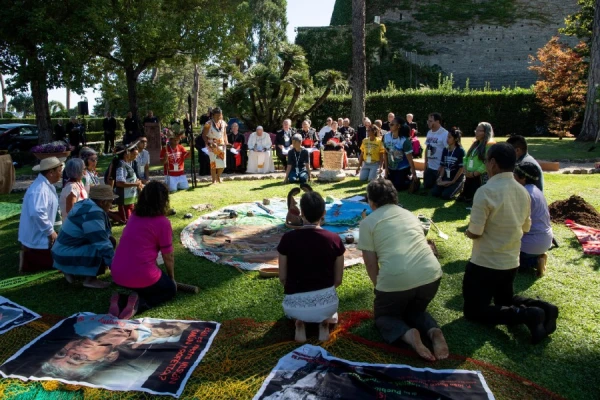
Vatican City, Apr 13, 2020 / 06:30 am (CNA).- Pope Francis has urged Catholics to pray for women who are currently caring for children, aiding the elderly, or working in healthcare or law enforcement amid the coronavirus pandemic.
In an address livestreamed from the library of the Apostolic Palace April 13, he noted that women were the first to tell the disciples that Jesus had risen from the dead.
“Today I would like to recall with you what many women do, even during this health crisis, to take care of others: women doctors, nurses, law enforcement officers and prison officers, employees of shops for basic necessities… and many mothers and sisters who find themselves locked in their homes with the whole family, with children, the elderly, the disabled,” he said.
Speaking immediately after he had recited the traditional Easter prayer, the Regina Coeli, he noted that the lockdown might place some women at greater risk of domestic violence.
“Sometimes they are at risk of being subjected to violence, due to a living situation in which they bear a burden that is far too heavy,” he said. “Let us pray for them, that the Lord may give them strength and that our communities may support them together with their families.”
In remarks before the Regina Coeli, the pope recalled that today is known in Italy as Lunedì dell’Angelo (Monday of the Angel, also known as Pasquetta), when “the joyful proclamation of Christ's Resurrection resounds”.
Standing beneath Pietro Perugino’s painting of the Resurrection, he said: “If Christ is risen, it is possible to look with confidence at every event of our existence, even the most difficult ones, full of anguish and uncertainty. This is the Paschal message that we are called to proclaim, with words and above all with the witness of life.”
“May this joyful news resound in our homes and in our hearts: ‘Christ, my hope, is risen!’ (Easter Sequence). This certainty strengthens the faith of every baptized person and encourages especially those who are facing greater suffering and difficulties.”
“May the Virgin Mary, silent witness of the death and resurrection of her Son Jesus, help us to believe strongly in this mystery of salvation which, welcomed with faith, can change our lives.”
After his address, the pope went to the window of the Apostolic Palace, where he would normally deliver his Regina Coeli address. He looked out over a nearly empty St. Peter’s Square and delivered his blessing.
At the end of the Regina Coeli, Pope Francis noted that some countries are seeing large numbers of infections and deaths as a result of the coronavirus, including Italy, the United States, Spain and France.
“I pray for them all. And don't forget that the pope prays for you, he is close to you,” he concluded.
If you value the news and views Catholic World Report provides, please consider donating to support our efforts. Your contribution will help us continue to make CWR available to all readers worldwide for free, without a subscription. Thank you for your generosity!
Click here for more information on donating to CWR. Click here to sign up for our newsletter.






Thus wrote Mahatma Gandhi: “Man can never be a woman’s equal in the spirit of selfless service with which nature has endowed her.”